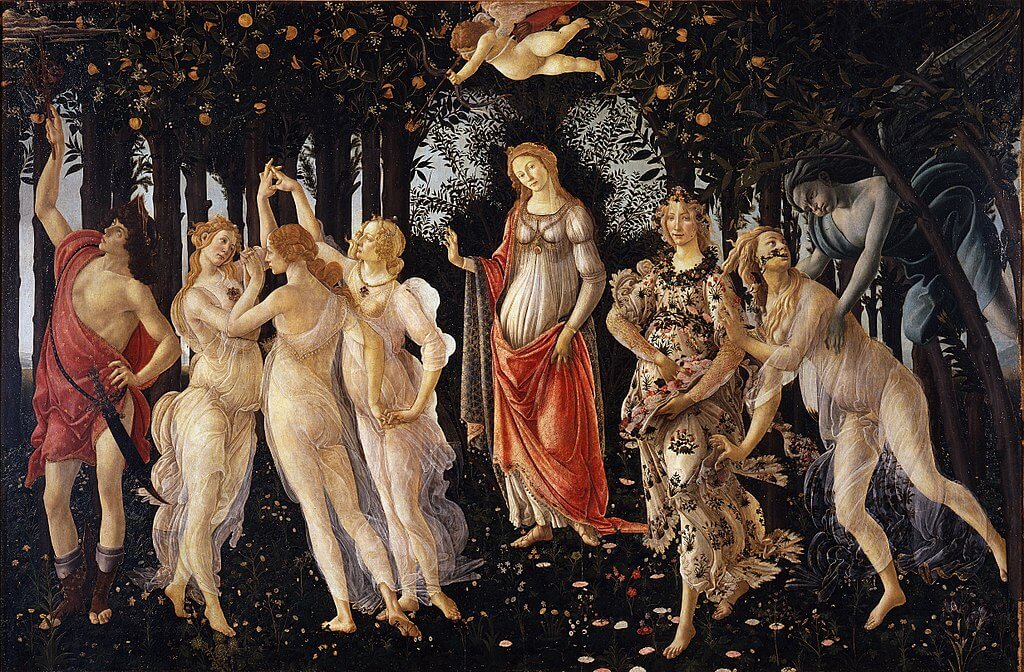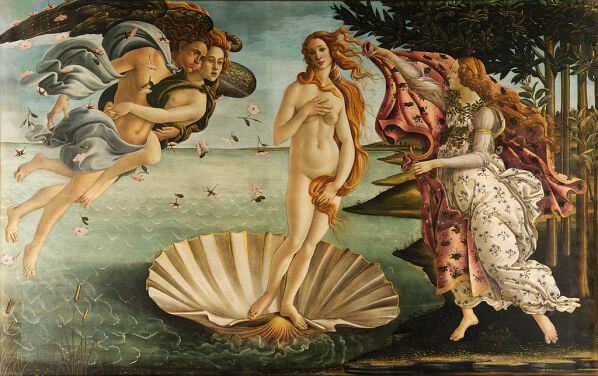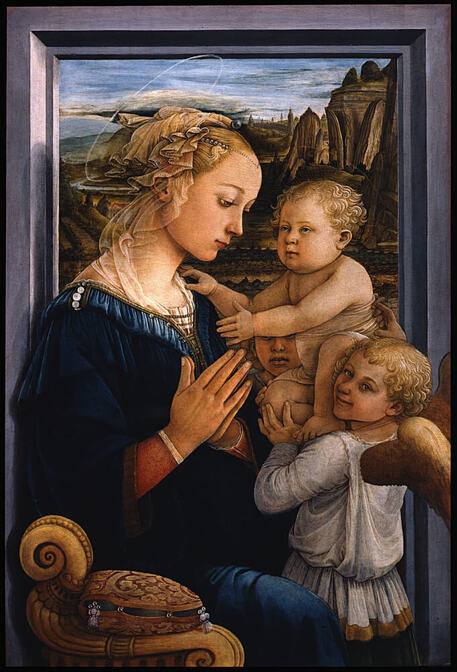|
Where? Room 10-14 of the Uffizi Museum
When? Between 1477 and 1482 Commissioned by? Lorenzo de’ Medici as a wedding gift to his cousin Lorenzo di Pierfrancesco de’ Medici What do you see? Eight figures in the meadow, surrounded by hundreds of different flowers. The blue figure on the right is Zephyr, the god of the west wind. Zephyr is chasing the nymph Chloris, who is associated with flowers and spring. Zephyr’s breath turns Chloris into the woman with the dress decorated with flowers (who is thought to be the goddess of Spring, called Flora). The central figure in the middle is Venus. To the left of Venus, the three Graces (Charites in Greek) are dancing. The Graces are minor deities in Greek mythology. To the left of the Graces is Mercury (Hermes in Greek), the messenger of the Greek gods, who is scattering the clouds with his staff. Some people say that Mercury may be modeled after Lorenzo de’ Medici who commissioned this painting. On top on Venus is Cupid (her son) aiming his flaming arrow at one of the Graces. Backstory: The painting only got his name, La Primavera in 1550 when Giorgio Vasari saw the painting, but it is also known as the Allegory of Spring ('primavera' is Italian for 'spring'). The painting is full of allegories (hidden meanings), which leads to much debate on how to interpret the painting. While many interpretations have been given, a popular interpretation is that the painting is inspired by a story from the poet Ovid. In his book Fasti (Amazon link to the book), the nymph Chloris is naked and attracts the first wind of the spring, which is represented by Zephyr. When Zephyr captures her, flowers sprang from her mouth and she turns into the goddess Flora. After Botticelli completed the painting, it was placed in the summerhouse of the Medici family, where it would hang next to The Birth of Venus which Botticelli completed a few years later.
Symbolism:
Who is Venus? Venus is the Roman goddess of love, beauty, sex, fertility, prosperity, and desire. Venus is also known in the Greek mythology as Aphrodite. Venus and Mars are the parents of Cupid. In art, Cupid is often depicted together with his mother, Venus. Why Venus? Nudity was the natural state of Venus, which provided a good excuse to include nudity in an artwork. This was an important reason for her popularity in Renaissance art. Whereas in this painting Venus is still dressed, this will quickly change. A few years later Botticelli painted The Birth of Venus in which she is already largely naked.
Who is Botticelli? Sandro Botticelli (1445-1510) was a painter who belonged to the Florentine school of painters. The name Botticelli means “little barrel”. He got this name because people described his brother as “fat like a barrel”. Botticelli was initially trained by his brother to become a goldsmith, but at the age of 14, he became an apprentice to the successful painter Filippo Lippi (1406-1469), known from the painting Madonna and Child with Two Angels. Later in his life, Botticelli became a mentor to both Leonardo da Vinci and Michelangelo.
Fun fact: The painting contains over 500 individual flowers and between 170 and 200 different varieties. Most of these flowers were growing in the spring around Florence. Botanical experts are already inspired for centuries by these flowers. They have been able to identify about 130 flowers, including daisies, forget-me-nots, jasmine, lilies, and violets. For the remaining flowers, there is quite some debate on whether these are fantasy flowers created by Botticelli or real flowers that existed in 15th century Florence but are now extinct.
Interested in a copy for yourself? Poster or canvas.
Written by Eelco Kappe
References:
2 Comments
Ron
8/26/2017 11:17:31 am
A rain of flowers descended
Reply
Leave a Reply. |
Categories
All
|
- Home
- Blog
-
Museums
- Alte Pinakothek
- Art Institute of Chicago
- Baltimore Museum of Art
- Barber Institute of Fine Arts
- Bargello
- Barnes Foundation
- British Museum
- Church of Sant’Anastasia
- Cleveland Museum of Art
- Courtauld Institute of Art
- Detroit Institute of Arts
- Frans Hals Museum
- Galleria Borghese
- Gallerie dell'Accademia
- Getty Museum
- Guggenheim
- Hermitage Museum
- Kunsthistorisches Museum
- Kunstmuseum Basel
- Legion of Honor Museum
- Louvre
- Mauritshuis
- Metropolitan Museum of Art
- Musee d’Orsay
- Museum of Fine Arts in Boston
- Museum of Modern Art
- National Gallery in London
- National Gallery of Art
- National Museum in Poznań
- Norton Simon Museum
- Ny Carlsberg Glyptotek
- Palace of Versailles
- Palazzo Pitti
- Palazzo Vecchio
- Petit Palais
- Philadelphia Museum of Art
- Prado
- Pushkin Museum
- Ravenna Art Museum
- Rijksmuseum
- San Diego Museum of Art
- Santa Maria delle Grazie
- St. Peter's Basilica
- Städel Museum
- Statens Museum for Kunst
- Tate Britain
- Tate Modern
- Timken Museum of Art
- Uffizi
- Vatican Museums
- Wallace Collection
-
Artists
- Altdorfer
- Anguissola
- Berlin Painter
- Bosch
- Botticelli
- Boucher
- Bronzino
- Bruegel the Elder
- Brunelleschi
- Cabanel
- Caillebotte
- Canova
- Caravaggio
- Carpeaux
- Cezanne
- Cimabue
- David
- Degas
- Delacroix
- De Maria
- Donatello
- El Greco
- Fontana
- Fra Angelico
- Fragonard
- Gauguin
- Gentileschi
- Gericault
- Gonzalez-Torres
- Goya
- Hals
- Hogarth
- Hokusai
- Ingres
- Leonardo da Vinci
- Lippi, Filippo
- Longhi, Barbara
- Lorrain
- Makovsky
- Manet
- Massys
- Matisse
- Merian
- Michelangelo
- Mochi
- Modigliani
- Monet
- Panini
- Parmigianino
- Perugino
- Picasso
- Pisanello
- Raphael
- Rembrandt
- Renoir
- Reynolds
- Rivera
- Rodin
- Rubens
- Scultori
- Seurat
- Steen
- Tintoretto
- Titian
- Toulouse-Lautrec
- Turner
- Uccello
- Van der Weyden
- Van Dyck
- Van Eyck
- Van Gogh
- Van Hemessen
- Vasari
- Velazquez
- Vermeer
- Veronese
- Vigée Le Brun
-
Locations
- Books
- About Us



